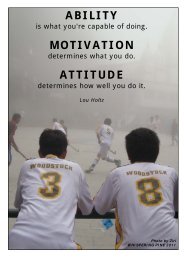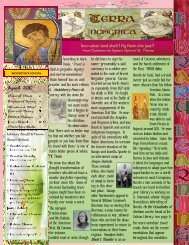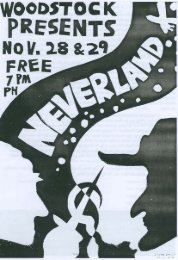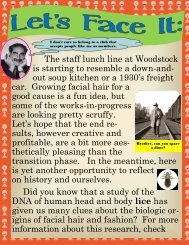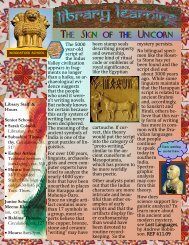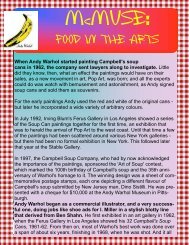Create successful ePaper yourself
Turn your PDF publications into a flip-book with our unique Google optimized e-Paper software.
Volume 1, Issue 2<br />
<strong>LIBRARY</strong> <strong>LEARNING</strong><br />
March 2012<br />
WOODSTOCK SCHOOL<br />
Inside This Issue:<br />
The First Novel? 2<br />
<strong>Woodstock</strong> When 2<br />
New Books 3<br />
Junior <strong>School</strong> News 4-5<br />
Dr. Seuss’ Birthday 6<br />
2012 Book Fair 6<br />
MUN Research 7<br />
To Learn More: 8<br />
SEO: Search Engine<br />
Optimization<br />
Library Staff & Hours<br />
Senior <strong>School</strong>:<br />
Sarah Colwell, Librarian,<br />
ext. 520<br />
Subashini Timothy,<br />
Circulation, ext. 517<br />
Esther Arthur, Technical<br />
Services (cataloging), ext.<br />
518<br />
Harry van Doorn, Library<br />
Assistant, ext. 517<br />
Hours: 8am-6pm, M-F<br />
Extended Study Halls<br />
(sign-up only) 6:30-8:45<br />
pm, Tues.-Thurs.<br />
Junior <strong>School</strong>:<br />
Meenu Khan, Librarian,<br />
ext. 127<br />
Rahima Thomas,<br />
Circulation, ext. 127<br />
8<br />
<br />
Libraries exist for the written<br />
word. If the preservation of<br />
recorded knowledge is our business,<br />
then symbols are our raw<br />
materials.<br />
Until recently, most archaeologists<br />
agreed that the earliest<br />
writing systems emerged during<br />
the Neolithic era, when<br />
humans began to settle down<br />
and grow sustainable staple<br />
crops. Populations expanded<br />
because of increased food supply<br />
and the need for more<br />
hands to participate in agriculture.<br />
Speech alone was not as<br />
effective in larger societies that<br />
needed shared information to<br />
live and get along.<br />
Writing began in these same<br />
regions of early settlement.<br />
Homo sapiens is the species<br />
that invents symbols in<br />
which to invest passion and<br />
authority, then forgets that<br />
symbols are inventions.<br />
Joyce Carol Oates<br />
Sumerian cuneiform, Egyptian<br />
hieroglyphs and the stilldeciphered<br />
Harappan script of<br />
Indus River settlements like<br />
Mohenjo-Daro are considered<br />
Stone Age Symbolism<br />
to be the oldest forms of writing<br />
in the world.<br />
The open-angle<br />
symbol appears in<br />
42% of subject sites,<br />
from 18 regions,<br />
across 6 continents<br />
over a period of 25,000 years.<br />
Two archaeologists from the<br />
University of Victoria in Vancouver<br />
have some new ideas<br />
about communication using<br />
symbols. As they studied the<br />
Paleolithic cave paintings that<br />
have been found in almost every<br />
part of the world where humans<br />
roamed 15,000-32,000<br />
years ago, GenevieveVon Petzinger<br />
and April Nowell began<br />
to notice similar symbols in<br />
far-flung places. Some of the<br />
most common of these appear<br />
in the line of images, above.<br />
Just as Stone Age artists everywhere<br />
depicted similar subjects<br />
in their paintings, our<br />
distant ancestors seemed to<br />
use a common set of symbols to<br />
express meaning that was comprehensible<br />
at least to other<br />
members of their society.<br />
Whether these glyphs had<br />
shared significance beyond a<br />
March is Women’s History Month<br />
particular hunter-gather territory<br />
is something we may never<br />
know. Linguists have identified<br />
elements of “protofamilies”<br />
of large language<br />
groupings such as Indo-<br />
European, the family that includes<br />
both Hindi and English.<br />
By definition, however, the<br />
prehistoric “record” lacks the<br />
documentary artifacts that<br />
would “tell” us more about prehistoric<br />
people.<br />
Cave Painting, Chauvet, c.30,000 BCE<br />
Early cave art like that of<br />
Chauvet, France, expresses<br />
motion, delight and perhaps<br />
the wonder that we still experience<br />
today when observe the<br />
beauty and power of nature or<br />
human skill. The 26 symbols<br />
that began to appear around<br />
the same time are just as expressive<br />
of the ancient and<br />
universal human experience—<br />
even if we don’t know<br />
what they mean.
Page 2<br />
Murasaki Shikubu at work<br />
The First Novel?<br />
Library Learning<br />
Murasaki means “purple”<br />
March is Women’s History Month and<br />
just as fitting time as any to celebrate<br />
the literary accomplishment of a woman<br />
who lived a long time ago.<br />
Though some debate whether Genji<br />
Monogatari, The Tale of Genji, can be<br />
considered the worlds’ first novel, there<br />
is no doubt that it is one of the most<br />
enduring books ever written.<br />
Murasaki Shikubu (973-1014 or 1025)<br />
was a lady-in-waiting in the Imperial<br />
Court of Japan during the Heian period,<br />
a time of significant artistic development.<br />
During this last period of classical<br />
Japanese culture (794-1185), Kyoto,<br />
the Imperial capital, was a center of<br />
great creativity in response to the influences<br />
of the Chinese scholarship, art<br />
and religion of the late Tang, Song and<br />
Yuan dynasties. The powerful Fujiwara<br />
clan ruled while the emperors presided<br />
over the rarified pleasures of<br />
court life. It was during this era that<br />
the samurai class arose to become the<br />
dominant force in Japanese political<br />
history until the country was forced to<br />
open its shores to the wider world.<br />
Hikaru (shining) Genji, the hero of the<br />
tale, is a younger son of a fictitious<br />
Japanese emperor and his favorite concubine.<br />
His story, narrated in many<br />
installments, has more to do with the<br />
young man’s romantic misadventures<br />
than any exploit of courage. Some critics<br />
consider Murasaki’s approach to be<br />
typically “feminine,” but others describe<br />
her approach as “psychological”<br />
and, at that time, unprecedented in<br />
world literature, east or<br />
west.<br />
Although Lady<br />
Murasaki was a<br />
well-educated aristocrat<br />
Heian kana<br />
who had learned Chinese, she wrote<br />
most of her lengthy tale in kana, the<br />
indigenous Japanese syllabaries. She<br />
apparently assumed that most of her<br />
readers would be women of the court,<br />
few of whom were able to read the imported<br />
kanji which, with the kana,<br />
make up the complex hybrid Japanese<br />
writing system still in use today. The<br />
aristocratic refinements of the Kyoto<br />
court are poetic, highly inflected and<br />
defy casual attempts at idiomatic<br />
translation. While most Japanese students<br />
read some portion of the original<br />
work in secondary school or university,<br />
the style of the book makes its somewhat<br />
racy content less accessible than<br />
its more modern counterparts. Much<br />
of the dialogue is written in verse.<br />
In some translations, the language of<br />
Genji seems archaic, but the intimate<br />
portrayal of the inner life rivals any<br />
modern exploration of love and disillusionment.<br />
Murasaki’s authorship is<br />
sometimes questioned because the<br />
elaborate work of many diligent years<br />
seems, to some, beyond the abilities of<br />
woman of her time. But, for a thousand<br />
years, The Tale of Genji has enjoyed<br />
a unique status in world literature.<br />
Lady Murasaki created not only a<br />
memorable hero but a revolutionary<br />
depiction of her<br />
protagonist’s inner life.<br />
FIC SHI<br />
<strong>Woodstock</strong> When?<br />
<strong>Woodstock</strong> was pleased recently to have<br />
welcomed back former girl’s dorm matron,<br />
Dorothy Yoder Nyce. Dorothy<br />
worked here over 50 years ago.<br />
Here’s some of what she remembers<br />
from that time:<br />
1962 - Reflections Fifty Years Later<br />
. . . Highlights of the K-Wing dorm located<br />
on the Quad’s second floor, a<br />
dorm for 7 th and 8 th grade girls (plus a<br />
few from grade 6), include the evening<br />
devotion and snack time. The girls,<br />
dressed for bed, came up the back stairway<br />
from K-Wing, through a three-foot,<br />
square hole into our bathroom, from<br />
there into our living-dining room. We<br />
reflected on moral teaching, sacred insight,<br />
religious arts and stories that<br />
enabled the girls to be responsible people<br />
of faith. One project that the girls<br />
valued was a weekly sheet of news that I<br />
posted inside the ‘john’ doors. Each<br />
sheet included thoughtful quotes, names<br />
The Quad in 1962<br />
about living together.<br />
of pairs of girls<br />
for remembering<br />
each other<br />
during that<br />
week, special<br />
events, facts<br />
about India,<br />
or reminders<br />
In addition to hosting the study hall<br />
five evenings a week, I counted items<br />
from each girl for the dhobi, and helped<br />
Shanti the dorm ayah to enable girls to<br />
care for their growing health issues.<br />
Less regular, but events that we enjoyed<br />
included: singing Christmas carols on<br />
the Quad stairway; preparing and presenting<br />
the play “Scrooge” for younger<br />
girls or parents available; taking a<br />
group of 8 th graders to Dehra Dun on a<br />
Saturday to rent bikes to ride around<br />
the forest preserve; and hikes—often<br />
accompanied by good friend Diana<br />
Biswas. One memorable day during the<br />
monsoon season, the principal declared<br />
the day “a clear day holiday.” With<br />
lunches packed, we headed for “the<br />
haunted house,” not being long gone<br />
before our umbrellas opened overhead.<br />
During one long week-end, we hiked<br />
short distances, as into the bazaar or<br />
out Tehri Road, and then returned to<br />
read together To Kill a Mockingbird. We<br />
also enjoyed a ‘dress-up,” special meal<br />
served in the staff lounge area (usually<br />
out-of-bounds for students)....<br />
Dorothy’s Books:<br />
-Jesus’s Clear Call to Justice, Herald<br />
Press, 1990.<br />
-Multifaith Musing: Essays & Exchanges,<br />
Evangel Press: 2010.<br />
-Strength, Struggle & Solidarity: India’s<br />
Women, Pinchpeny Press, 1989.<br />
-Weaving Wisdom: Sermons by Mennonite<br />
Women, Womensage, 1983.
Page 3<br />
New Books<br />
How is the Internet Changing the<br />
Way You Think is a<br />
collection of essays edited<br />
by John Brockman<br />
and includes contributions<br />
from Richard<br />
Dawkins, Stephen<br />
Pinker, Brian Eno, Sam<br />
craft. The artistry of quilt-making<br />
around the world has become better<br />
known in recent decades, with heirloom<br />
pieces fetching as much as<br />
$100,000 in US auction houses. Thankfully,<br />
razai remain both beautiful and<br />
accessible.746.46 HEL<br />
Struggle for Freedom: the Role of<br />
cultural exchange that<br />
made Mongol rule as tolerant<br />
as Mongol conquest<br />
was brutal. Her influence<br />
over the greater part of the<br />
Eurasian land mass puts<br />
her in the ranks of the most<br />
powerful women in history.<br />
950.2092 WEA<br />
Harris, Ai Weiwei and many other<br />
“leading intellectuals.” This collection,<br />
like the Internet, as described by one<br />
contributor, author Judith Rich Harris,<br />
“dispenses information the way a<br />
ketchup bottle dispenses ketchup. At<br />
first there was too little; now there is<br />
too much. In between, there was a halcyon<br />
interval of just-enoughness.”<br />
004.67 BRO<br />
Copyright Clarity: How<br />
Fair Use Supports Digital<br />
Learning, by Renee Hobbs,<br />
dispels some common misconceptions<br />
about responsible<br />
use of intellectual property<br />
for educational purposes.<br />
While some of the key concepts Hobbs’<br />
discusses are hard to codify definitively—“transformative<br />
use,” for example—the<br />
book is useful and encouraging.<br />
As information and related issues<br />
of “ownership” evolve, it’s important<br />
for educators to remember that, when<br />
undertaken in good faith for instructional<br />
purposes, “fair use” refers to<br />
rights as well as to restrictions. PLC<br />
346.048<br />
There are probably very few of us who<br />
don’t have a colorful and comfortable<br />
razai on the bed at this time of year.<br />
Chandramani Singh<br />
and Krystyna Hellström’s<br />
beautifully<br />
photographed Jaipur<br />
Quilts does honor to<br />
this seemingly humble<br />
Delhi, by Reva<br />
Dhanedhar, marks the<br />
centenary year of the<br />
founding of the transfer<br />
of the Capital. The book<br />
recounts the history of<br />
the city and its role in the<br />
struggle for independence from 1857 to<br />
the Red Fort at midnight ninety years<br />
later. Dr. Dhanedhar includes detailed<br />
accounts of major satyagraha and party-based<br />
political initiatives, as well<br />
as the role of outlying villages that<br />
are now a part of the greater metropolitan<br />
area. Her archival research<br />
is extensively documented in notes<br />
and appendices. The bibliography<br />
contains lists of books, government<br />
documents and private<br />
papers that would enrich<br />
any research project on<br />
this vital period of modern<br />
Indian<br />
history. 954.035 DHA<br />
The Secret History of the<br />
Mongol Queens: How the<br />
Daughters of Genghis Khan<br />
Rescued his Empire plays on<br />
the title of the classic 13 th century<br />
epic poem about the conqueror<br />
of the largest contiguous empire ever<br />
established. Author Jack Weatherford relies<br />
heavily on the original Secret History in<br />
this review of the lives of the women of<br />
the great Mongol clans. Consider Sorkhokhtani<br />
Beki, a daughter-in-law of<br />
Genghis Khan, for instance. A Nestorian<br />
Christian, Sorkhokhtani was responsible<br />
for much of the commercial and<br />
Aung San Suu Kyi: a Biography, by Swedish<br />
journalist Jesper Bengtsson, is a relatively<br />
new account of the inspiring life of the<br />
Burmese pro-democracy leader and Nobel<br />
Peace Prize laureate who has spent most of<br />
the last two decades under house arrest, deprived<br />
for years at time from contact with her<br />
family and her people. B Aung 2012<br />
Philosopher Simone de Beauvoir first published<br />
The Second Sex in 1949. Constance<br />
Borde and Sheila Malovany-<br />
Chevallier’s new translation is not so<br />
much a revision as a reminder of the<br />
intellectual achievement of Beauvoir’s<br />
massive analysis of the existential role<br />
of women history, art, religion and<br />
politics. Eclipsed in part by the author’s<br />
larger-than-life personality and outmoded by<br />
its own ambitious scope, the book is still the<br />
classic work in the field of women’s studies.<br />
305.4 BEA<br />
The Hindus: an Alternative<br />
History by scholar Wendy Doniger,<br />
is an elaborate examination<br />
of Hinduism from its earliest<br />
mythic texts to its current cultural<br />
manifestations in India and the<br />
rest of the world. She provides as<br />
well a strong historical perspective from<br />
source material outside the Hindu canon.<br />
We thank Mr. & Mrs. Wunker for this generous<br />
donation. 294.5 DON<br />
Coming soon: a DVD doubleheader:<br />
Anne of the Thousand Days &<br />
Mary Queen of Scots.<br />
AV 942.05
JUNIOR SCHOOL <strong>LIBRARY</strong><br />
THE STORY STARTS HERE…………..<br />
It’s been a long cold winter but it’s nearly over. While we’re<br />
waiting for the spring colors, we’ve got lots of activities to<br />
do. First we have to celebrate a few famous authors’ birthdays...find<br />
out who all were born in March.<br />
The most widely celebrated<br />
March birthday of children's book<br />
author was that of Dr. Seuss on<br />
March 2.<br />
MARCH 5 - MEM FOX<br />
MARCH 6 - CHRIS RASCHKA<br />
MARCH 11 - EZRA JACK KEATS<br />
LKHHH<br />
MARCH 21- DAVID WISNIEWSKI<br />
Book Club:<br />
Every Thursday after school in the Quad Library<br />
with Ms. Khan<br />
If you are fascinated by books and love reading,<br />
Book Club could be one of the most enjoyable<br />
ways of indulging in your hobby.<br />
Here’s what students do in the club--- There<br />
are nine members. At present the focus is on<br />
the Caldecott Award Books. The club has a<br />
group in the Shelfari where they add all the<br />
books on the shelf and write reviews as well.<br />
They also have chance to participate in discussions<br />
about books they have read, as well<br />
as be introduced to new books.<br />
Quad Library<br />
celebrated Dr. Seuss’ Birthday<br />
by doing lots of activities :<br />
*Hat Competition<br />
*Dress up like a character<br />
from Dr.Seuss’ Books<br />
*Poster competition depicting<br />
Dr.Seuss’ life and<br />
accomplishments<br />
*Poetry Writing<br />
see following pages for more!<br />
New DVD’s!!!<br />
-Alvin and the Chipmunks<br />
-Cheaper by the Dozen<br />
-Mr. Popper’s Penguins<br />
-The Muppet movie<br />
-Devil May Hare
Read Poems by Grade 2 Students in<br />
Dr. Seuss’s Rhyming Style<br />
Anna Snader<br />
Anishka Joab<br />
Mahima Peters<br />
Next month watch out for more Library<br />
news! Till then keep reading!<br />
Thank you,<br />
Ms. Khan!<br />
JS Librarian
Dr. Seuss Postage Stamp<br />
I wish I had a hat!<br />
Page 6<br />
Jr. <strong>School</strong> Celebrates Dr. Seuss’ Birthday<br />
From the time when our<br />
mothers were first able to<br />
scrape what little fluff we had<br />
on our heads into<br />
a bad Who hairdo, Dr. Seuss<br />
has been a friend to many of<br />
us at <strong>Woodstock</strong>.<br />
Junior <strong>School</strong> students recently<br />
celebrated the long<br />
relationship between young<br />
readers and artist-poet Theodore Seuss<br />
Geisel, the author of 46 beloved books for<br />
children, on the occasion of his<br />
108th birthday.<br />
Geisel was born on 2 March<br />
1904, in Springfield, Massachusetts.<br />
By the time he began<br />
studying at Dartmouth College,<br />
he was already an aspiring<br />
humorist. He went on<br />
to study at Oxford, to apply his creative<br />
talents to commercial advertising and<br />
then to public information and film production<br />
during WWII. Illustrating his<br />
own comic stories, many written in anapestic<br />
tetrameter, a style inspired by<br />
the<br />
rhythm of<br />
ship engines,<br />
eventually<br />
his full-time<br />
He also collabo-<br />
film projects<br />
mated specials,<br />
the award-<br />
holiday<br />
How the<br />
became<br />
career.<br />
rated in<br />
and aniincludinwinning<br />
classic,<br />
Grinch Stole Christmas, memorably<br />
narrated by Boris Karloff. In 1984,<br />
Dr. Seuss was given a Pulitzer Prize<br />
for his 50-year contribution to American<br />
literature.<br />
“Fun is good.”<br />
Oh, the places you’ll<br />
go!<br />
Geisel had strong liberal convictions<br />
and used his humor to protest social injustice<br />
and political oppression.<br />
<strong>Woodstock</strong> Junior <strong>School</strong><br />
students observed Geisel’s<br />
birthday with a weeklong<br />
series of events including<br />
guest read-aloud sessions<br />
in the JS Library, art projects,<br />
Dr. Seuss trivia and general Seussstyle<br />
silliness. Students reported<br />
that, while there were<br />
no green eggs or ham on offer,<br />
there was plenty of fun for<br />
everyone who participated.<br />
Do WS Seuss fans have a favorite<br />
book? According to<br />
Library statistics, the books<br />
JS students like best are The Cat<br />
in the Hat, an entertaining tale of<br />
babysitting gone wrong, The Lorax,<br />
now a major motion picture,<br />
and The Foot Book, no explanation<br />
required.<br />
If you haven’t read a Seuss classic<br />
for awhile, you might want to remember<br />
that, according to Seuss himself,<br />
“Adults are obsolete children...you make<br />
‘em, I amuse<br />
‘em.” So don’t<br />
be a Grinch:<br />
roast some<br />
roast beast<br />
and say:<br />
Why am I here?<br />
The 2012 <strong>Woodstock</strong> Book<br />
Fair was held on Saturday,<br />
3 March, in the Quad<br />
dining hall.<br />
Vendors from<br />
Scholastic in Delhi, Natraj<br />
Publishers of Dehradun, Om<br />
Books and Cambridge<br />
Book Depot, both of Mussoorie,<br />
brought an extensive<br />
array of new titles<br />
for students and staff to<br />
purchase.<br />
Meenu Khan, JS Librarian,<br />
was responsible for organizing the<br />
event and a number of staff volunteered<br />
their time. Mrs. Long and Mrs. Mark<br />
opened the fair bright and<br />
early, as JS students were<br />
A person’s a person, no matter how small. -- Dr. Seuss<br />
2012 Book Fair Goes to the Dogs<br />
waiting en masse at the<br />
entry door. SS students<br />
were scheduled for the afternoon.<br />
In addition to<br />
choosing books for personal<br />
reading, teachers and students<br />
made suggestions to library<br />
staff regarding our collections.<br />
Some of the new titles featured in<br />
this newsletter were Book Fair acquisitions<br />
initiated by you.<br />
The highlight of the morning was a reading<br />
by India<br />
Today Deputy<br />
Editor, Dhiraj<br />
Nayyar, from<br />
his new book,<br />
Journalist Dhiraj Nayyar speaks to JS<br />
Students.<br />
How Cheeka Became a Star<br />
and Other Dog Stories. Mr.<br />
Nayyar, who is from Delhi and<br />
attended both Oxford and Cambridge,<br />
explained to students that he had edited<br />
this collection of personal accounts<br />
because he has come to love dogs<br />
only in recent years, after fearing<br />
and disliking them<br />
as a child. He<br />
told us how one<br />
particular dog convinced<br />
him to give all dogs a<br />
chance. JS students<br />
then told their own<br />
dog stories. Afterwards,<br />
much to the<br />
students’ delight, Mr.<br />
Nayyar kindly autographed<br />
each of their books.<br />
I wasn’t invited...<br />
Woof!<br />
Give dogs a<br />
chance!
7<br />
Managing Controversy: MUN & Everything Else<br />
Everything will be all right ...when people, just people, stop thinking of the United Nations as a weird Picasso abstraction<br />
and see it as a drawing they made themselves. -Dag Hammarskjöld<br />
Pablo Picasso (1881-<br />
1973) was still at<br />
work when Dag Hammarskjöld<br />
was serving<br />
as Secretary of the United Nations.<br />
Hammarskjöld died in 1961, in a plane crash<br />
en route to a cease-fire negotiation in presentday<br />
Zambia, then part of colonial Rhodesia.<br />
Years earlier it had been Picasso’s Guernica,<br />
pictured above, that had contributed<br />
to international outrage over the fascist<br />
bombings of civilians during the<br />
Spanish Civil War (1936-39), a conflict<br />
many historians consider the precursor<br />
to World War II (1939-1945) and, consequently,<br />
the establishment<br />
of the United Nations<br />
shortly before the<br />
surrender of Nazi Germany.<br />
Anyone who has visited<br />
UN headquarters (or<br />
UN Headquarters seen Alfred Hitchcock’s<br />
North by Northwest), is<br />
likely to realize that the collaborative<br />
design of architects le Corbusier and Niemeyer<br />
is a monument to a modern humanist<br />
aspirations. So why does the<br />
mere existence of the<br />
United Nations continue<br />
to provoke controversy<br />
after nearly<br />
seventy years?<br />
Researching the facts<br />
surrounding controversial issues is a critical<br />
step to navigating any dispute, academic<br />
or otherwise. <strong>Woodstock</strong> Library<br />
subscribes to the Points of View online<br />
service through the academic information<br />
mega-vendor, EBSCOHost, a resource<br />
you’ll probably be using in your college or<br />
university before<br />
too long. POV is<br />
easily accessible via<br />
the WSWire<br />
“Subscriptions”<br />
link, and no longer If the shoe fits...<br />
requires WS students<br />
to enter a username or password.<br />
Select the POV (EBSCO) hyperlink and<br />
you’re taken directly to the database.<br />
You can choose from a list of topics or do<br />
Here it is!<br />
a keyword or advanced search<br />
to find expert point-counterpoint discussion<br />
on a number of current global<br />
issues.<br />
You also have<br />
access to a<br />
wealth of magazine<br />
and newspaper<br />
articles,<br />
scholarly research,<br />
full-text<br />
eBooks, radio<br />
& TV transcripts,<br />
primary<br />
sources such as<br />
speeches, charters,<br />
interviews,<br />
testimony, government<br />
documents,<br />
UN resolutions<br />
and bibliographies<br />
with<br />
still more links to<br />
useful, mostly ad-free resources. You<br />
can also link to legal images and serious<br />
video clips on current events.<br />
There are helpful research guides for<br />
taking notes, preparing<br />
outlines, evaluating websites<br />
and facts v. opinions.<br />
The essay-writing<br />
tool, reference guide to<br />
curriculum standards<br />
and citation tool make<br />
this site a great place to<br />
conduct and prepare your<br />
research.<br />
UN Charter on<br />
EBSCO. Hear it<br />
read in the accent<br />
of your choice:<br />
American, British<br />
or Australian!<br />
Another feature of the EBSCO services is<br />
the ability to get notification by email<br />
when your search comes up with<br />
something new. For this feature, you<br />
will need to create your own login ID and<br />
password. It’s as easy as online shopping<br />
and no credit card is required. Many<br />
years ago, when this former student participated<br />
in MUN, my team, the India<br />
delegation, eclipsed the thensuperpowers<br />
US & USSR by being more<br />
current about a news-making nuclear<br />
disarmament initiative than the Washington<br />
or Moscow delegates were themselves.<br />
And we didn’t have online services<br />
with automatic update tools.<br />
Need general background information<br />
of the country to which<br />
you’ve been assigned? Try<br />
Country Reports online service<br />
(see access instructions<br />
above). You still need to login<br />
to get the full range of services<br />
available. User<br />
ID is woodstockschool<br />
password is tigers<br />
You can all the core and<br />
current facts about your<br />
nation as well as links to<br />
other sources.<br />
When you’re looking up<br />
country or issue facts in<br />
the Library Catalog,<br />
remember to check<br />
WebPath from the same search screen.<br />
And if you need more help, just ask!
WOODSTOCK SCHOOL<br />
To Learn More:<br />
<strong>Woodstock</strong> <strong>School</strong><br />
Vera Marley Library<br />
Tehri Road, Landour<br />
Mussoorie, Uttarakhand<br />
+91-0135-6115517<br />
+91-0135-6615520<br />
+91-0135-6615000<br />
library@woodstock.ac.in<br />
Sarah Colwell<br />
Senior <strong>School</strong> Librarian<br />
SarahColwell@woodstock.ac.in<br />
Meenu Khan<br />
Junior <strong>School</strong> Librarian<br />
MeenuKhan@woodstock.ac.in<br />
-For more about Paleolithic art see: The Cave Painters: Probing the<br />
Mysteries of the World’s First Artists, by Gregory Curtis 709.01<br />
CUR 2006<br />
-Coming soon to DVD: Werner Herzog’s acclaimed Cave of Forgotten<br />
Dreams, documentary about what is possibly the oldest art<br />
work on earth at Chauvet-Pont-d’Arc, in France, with paintings<br />
that date from 32,000 BCE.<br />
-To see more new books added to our Library, go to<br />
V:\SupportDepartments\Libraries\HSLibrary\New Books\New<br />
Books in the <strong>Woodstock</strong> Libraries.docx<br />
-To find out what Dr. Seuss books we have in the JS Library, go to<br />
V:\SupportDepartments\Libraries\QuadLibrary\Seuss.docx<br />
-For new Hindi books, see:<br />
V:\SupportDepartments\Libraries\e-publications 2011-<br />
2012<br />
Coming in April: AROUND THE WORLD IN EIGHT PAGES! If you want to submit an article or news, let us know.<br />
You’re @ the Top: Search Engine Optimization<br />
Last month we talked about Wikipedia, the free<br />
do-it-yourself online encyclopedia that is almost<br />
impossible to avoid. Have you<br />
ever wondered why Google<br />
ranks Wikipedia articles near the<br />
top of almost every search you<br />
execute? Is it some kind of conspiracy?<br />
Not exactly. Neither<br />
Wikipedia nor Google profit directly by getting<br />
you to read Wikipedia first. The secret to the<br />
search-engine success is SEO: search engine<br />
optimization.<br />
Most of us would probably have to admit that,<br />
when looking for basic information on most<br />
topics, we rarely move beyond the first 3-5 pages<br />
of sites that our search engine pulls up. Some<br />
students have told me that they rarely look past<br />
the first page of search results. If we use the<br />
Google default display of 10 articles per page,<br />
that means we’re going to scan, at most, the first<br />
50 hits of the vast numbers that may meet our<br />
search criteria. SEO is a process that increases<br />
website exposure by maximizing apparent relevance.<br />
To understand SEO, it helps to have some idea<br />
of how Internet search engines rank the relevance,<br />
or the “aboutness” of a specific URL’s.<br />
Data retrieval once required human researchers<br />
to master complex search syntax, and enter<br />
search terms according to the dictates of mathematical<br />
logic. Skilled indexers, usually librarians<br />
with special subject expertise, assigned<br />
metadata, such as subject headings and summaries<br />
called abstracts, to the records content providers<br />
considered important enough to publish.<br />
Today, online information is no longer limited<br />
to data that is “important.” Anyone with a computer<br />
and an opinion can become an information<br />
“provider.” As a result, online research is mostly<br />
free, allows the use of “natural language”<br />
and, consequently, is sometimes highly imprecise.<br />
What’s really going on behind the<br />
scenes?<br />
In addition to “crawling” the Web to match<br />
our search terms to retrieve “relevant” information,<br />
the more popular search engines index,<br />
or categorize data using algorithms based on<br />
logic and probability. What used to be a task of<br />
human beings now happens automatically, on<br />
the fly, as the search engines scan vast amounts<br />
of data to find the terms you entered. But, as<br />
fast and powerful as they are, search<br />
engines aren’t necessarily clever<br />
when it comes to the sort of content<br />
recognition we call meaning. It would<br />
seem that “aboutness” is sometimes more<br />
a matter of method than discernment.<br />
Not again!<br />
One method of raising a website profile<br />
is to increase keyword density and placement.<br />
The “spiders” that crawl through<br />
billions of bits of data look for terms that<br />
are repeated throughout a URL and that<br />
have placement in key segments of the<br />
record. One recurring principle of SEO is recursion.<br />
It’s an easier concept to illustrate or joke<br />
about than it is to describe. For example, when I<br />
ran the term “recursion” through Google, I got<br />
the response: Did you mean: recursion --an<br />
old jest originated by mathematicians, recursive<br />
to computer programmers. The product labels<br />
for Droste Cocoa and Quetzelteca Especial are<br />
examples of a famous and not-so-famous use of<br />
recursive patterns. The repetition of self-similar<br />
images within the larger image is a model for a<br />
well-designed website, the kind that is more<br />
likely to create the appearance of keyword density<br />
and thus rank higher in query results list.<br />
Spammers and other “black hats” can use these<br />
methods in disingenuous ways to attract<br />
search engine spiders.<br />
Because Internet data is linked in what<br />
we call the Web, the relationships within<br />
and between URL’s create a new kind of<br />
metadata. Search engine algorithms like PageRank,<br />
Google’s proprietary formula, assign<br />
great importance to a URL’s incoming and outgoing<br />
links. The more links, and the better they<br />
are, the higher the ranking. But search engines<br />
are wary of too many links suddenly changing a<br />
website’s ranking. BMW and JC Penny’s<br />
attempts at SEO were considered fraudulent<br />
because they created too many bogus links<br />
to and from abandoned or irrelevant<br />
URL’s. Google cited JC Penny and, for<br />
a time, punished BMW by removing the<br />
company from all it’s search results.<br />
The HTML nofollow operator instructs<br />
search engines to ignore dubious<br />
“organic” links that have developed<br />
by chance. One data<br />
provider that doesn’t use<br />
nofollow is the English<br />
version of Wikipedia.<br />
That accounts<br />
in part for its high<br />
rankings in your<br />
search results. It’s<br />
something to<br />
think about.<br />
I’m just in the way, as the<br />
French would say, “de<br />
trop” - Cole Porter<br />
I’m the King<br />
of the World!



